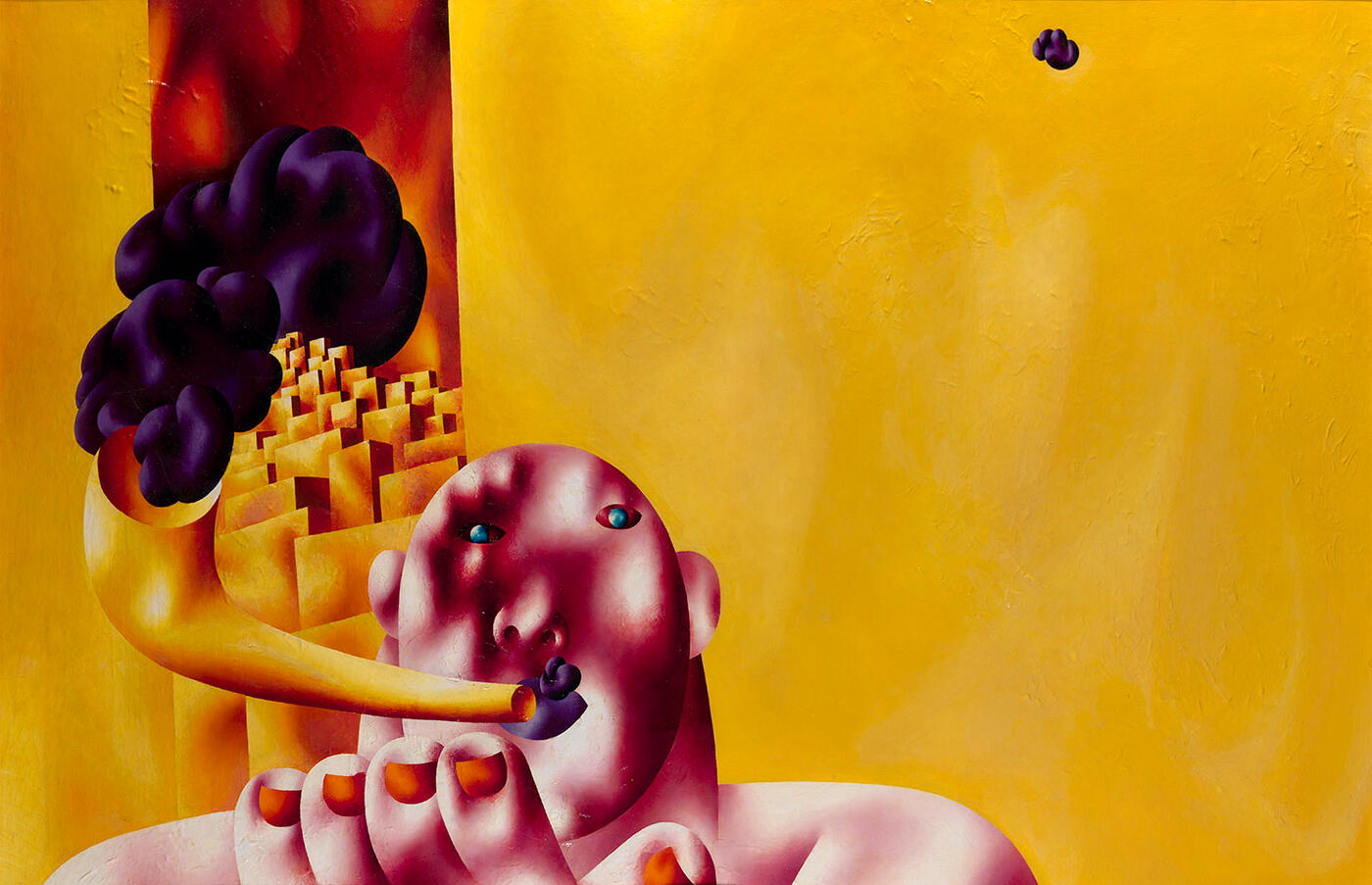MacDougall Auctions 2-3 December 2009
2 December 2009

* § 532. TSELKOV, OLEG B. 1934
Smoker signed, titled in Cyrillic and dated 1969 on the reverse
Oil on canvas, laid on panel, 100 by 152.5 cm.
90,000-150,000 pounds
Provenance: Acquired directly from the artist by the present owner.
Private collection, USA.
Authenticity has been confirmed by the artist.
Literature: Oleg Tselkov, Le Grandi Monographie, Turin, Fabbri Editori, 1988, p. 67, illustrated.
Roger Pierre Turine, Oleg Tselkov, Bonfi, Moscow, 2002, p. 33, illustrated.
Related literature: For similar works, see Roger Pierre Turine, Oleg Tselkov, Bonfi, Moscow, 2002.
The image of the “pipe smoker” became one of the most important in Tselkov’s creative oeuvre during the second half of the 1960s. Evolving from the still life of 1964, in which a grey, large-toothed face, two long smoking pipes and a burning candle form the traditional vanitas composition, evocative of the “nature morte” of African totems and of ancient Latin American art, to the self portrait of 1969, and the suite which is made up of several impressive compositions of the same name, the image of “the smoker” grows, not only in relation to scale, but also in terms of meaning. This represents one of the allusions, which can occasionally be found in Tselkov’s works, to classical museum art - “the smokers”, a popular subject for painters, beginning with the Dutch and Flemish school of the 17th century, and continuing up to the time of Cezanne and Gris that became the darlings of the 20th century.
Yet, Tselkov’s smoking monsters are merely a fragment of a classical painting, the spatial and compositional structure of which, containing references to well known iconographic motifs and traditional subjects, is merely a trick, a theatrical effect, designed to emphasise the alien nature of Tselkov’s world. Before us we do not see real people, whether in the form of a self-portrait of the artist or a canvas presented at the auction, but a world of simulacrums, in which genuine existence is wholly impossible. There is, therefore, no visible distinction between the genuine and the surrogate, nor is there any real difference between the mask and the face. The large toothed and toothless “Tselkov mugs”, which have been painted in the traditional palette of various shades of red, apathetically and, for no apparent reason, inhale and exhale clouds of grey and violet smoke. This smoke has poisoned everything that surrounds them: the yellow featureless towns and the spatial dimensions of life, squeezed into a frame and suspended by a nail. At the same time, Tselkov’s works contain no hint of the pathos of a Soviet poster calling for the battle for a better world; rather, what is at issue here is the metaphysical death of modern man and his urban world, in which, to use the words of the artist himself, no trace of “the face of god” remains.
A student of the legendary theatre designer Nikolai Akimov, from his early days Tselkov was fascinated by experimenting with the “Jack of Diamonds” style of painting. However, the artist’s present-day fame has come about thanks to his so called “ugly mugs”: his bright, almost surrealistic canvases depicting round-headed creatures, which resemble humans with flabby bodies, blank eyes and large, glossy mask-like faces.
Painted in bright, sparkling colours, usually against a black background, these “poster-like” garish images became a popular symbol in the West, as early as the 1970s, of the Soviet artistic underground: a caricature, in a sense, of Homo Soveticus. Tselkov himself stated that “I painted a portrait, so to speak; not a portrait of any individual subject, but, rather, a universal portrait of every human being, synthesised into one face, and one which is horribly familiar… This face is the face of modern humanity as a whole. I did not set myself the task of ‘ripping off the mask’: rather, I saw neither ‘good’ nor ‘bad’, but something which was more real, more than skin-deep. And it is what we all are under the skin that brings all of us closer together. I cannot make any specific accusations against any particular person, but I am making more than a specific accusation against the large numbers of people who degrade one another, torment one another, and do away with one another. I am entitled to make such charges in relation to the past, the present and the future …”
Tselkov was forced to leave for the West in 1977, where his work was compared to that of Fernand Leger, Francis Bacon and Fernando Botero, and occasionally to the later work of Kazimir Malevitch. As a result of Dovlatov’s famous story, the artist himself became a semi-mythical hero of underground art.
Since that time, Tselkov’s works have found their way into museum collections on both sides of the Atlantic; as well as into public and private collections in Russia, the United States, France and Japan. Solo exhibitions of his work have been held in the Russian Museum and the Tretyakov Gallery, and the value of the artist’s works has risen in proportion to the increasing size of the paintings, which between the 1980s and 1990s, reached truly gigantic, mural-like dimensions.
Notes on symbols:
* Indicates 5% Import Duty Charge applies.
Ω Indicates 20% Import Duty Charge applies.
§ Indicates Artist's Resale Right applies.
† Indicates Standard VAT scheme applies, and the rate of 20% VAT will be charged on both hammer price and premium.